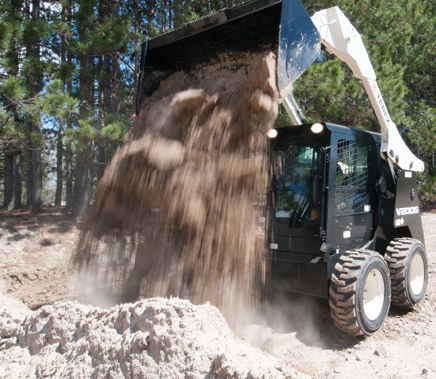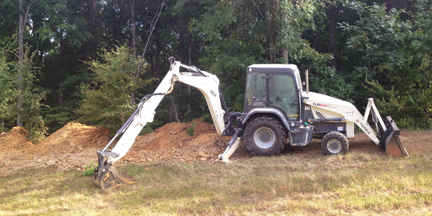Targeting Rental Channel Needs - Terex' New Line-Up
Design Objective: Equipment That Helps You Make Money
by Mike Martin
The rental market is growing and machinery manufacturers say they are paying more attention to what you need for your contractor customers. That should be good news – if the products reflect what you need: Durability, ease-of-use, ease-of-maintenance and a price that lets you acquire equipment and rent it at a competitive and profitable rate.
 |
| Dean Barley, Terex |
In early September, 2014, Terex Construction rolled out a new line of skid steer and compact track loaders (CTLs) targeted to rental centers. The company will be launching late this year or early 2015 a new rental-targeted backhoe, which was put through its paces on job sites this summer and fall. The current “GEN 2” skid steers and CTLs have rated operating capacity (ROC) of 665 pounds to 2,300 pounds. The company is promising more in the 2,300-pound to 3,600-pound ROC range.
Clearly, Terex is placing some significant bets on the rental channel, doing so for two reasons. First, it’s projecting that the rental market will continue to grow. Second, feedback from dealers, rental centers and end-users, as a follow-up to a 2011 introduction, pointed the company’s engineers in a slightly different direction.
Focusing on need, opportunity
For growth, the company believes 2014 and ’15 will continue strong, show six or seven percent for the next two years, slow in 2018 and flatten in 2019.
If that projection holds, the company has three to four years of running room to tap into a growth market with its new line.
To do so, explains Dean Barley, vice president of Terex Construction Americas and Global Aftermarket, the company had to take a fresh look at its product offering. “When we launched the new skid steer in 2011, it was primarily with our (dealer) distribution base in mind, to be quite candid. We didn’t ignore the rental market; we factored in a lot of things that we thought were important for rental, based on the feedback that we had at that time,” he says.
They saw, though, that dealers were stocking more products for rental and Rental Purchase Options; contractors were still uncertain about the economy, with more choosing to rent than buy. Following that trend, they also recognized that some customers were buying more machine than they needed for the bulk of their applications. Which means they were “spending more than what they need to spend,” Barley says.
From a revenue standpoint, that might warm a few hearts. It could even be argued that a contractor might “buy up” to have more power and options for future projects. However, given Barley’s background as an engineer who had worked for a couple of rental companies, and based on comments from rental company partners, plus the growing demand in rental, he felt a need to dive deeper.
“We went to our rental partners and we said, ‘Okay, tell us what’s important for you.’ It was made very clear to us that the rental community wants a reliable product that’s simple, cost-effective and it delivers superior return on invested capital,” Barley comments.
He distills the challenge down to this: “The right product for the right job, nothing more, nothing less.”
Product development “gates”
How do you get there? Terex starts with its NPPD - New Product Process Development. They move through five “gates,” to get from idea to production.
 |
| "The right product for the right job" |
The first gate, Barley says, is to flesh out the concept. This took a bit of a twist for development engineers, he points out, who typically are engaged with creating something bigger and better. “The main thing we kept asking ourselves was ‘okay, that sounds great, but what is it going to give the rental center customer? Is it going to make them more money?’ Because that’s the key question. We were working to not add cost.”
From there, the company moves through an initial development stage, identifying the type of product that should meet the concept’s objectives. Next comes design and costing, so they have a better idea of what the machine is likely to cost. Test units are built, with components and the product tested inside the plant and on a test track, then on job sites.
If it continues to show that it’s on-track to meet the objectives, gate five is the final run-down on the testing outcomes and user feedback. “It’s gone through all the testing phases, it’s gone through the reliability checks, it’s passed off internally, from a cost perspective the costs are what we thought they were going to be, the quality and reliability are what we thought they would be and the performance is what we thought it was going to be.” After that, he says, the former concept moves into production.
Knowing what’s needed – and what isn’t
For the new skid steers and track loaders, the process started by defining what wasn’t needed from the 2011 model. Follow-up discussions and research focused on the class sizes to roll out first, which ended up pointing to the smaller sizes. “Then, when we came out with what we thought the classes were, we went back and said ‘Okay, what are you looking for in those classes’?”
Field feedback clarified the need: a product that “has an attractive price that would deliver the return on investment that our rental customers are looking for. We know that it has to have reliability and quality, and that it needs to fall into that cost bracket that allows rental customer to achieve a profitable rental rate,” Barley says. “We can’t out-price the machine or the rental rate for the market.”
Technology, complexity and more power can lead to an overpriced machine – at least one that’s overpriced for the jobs it’s typically asked to accomplish. And if it’s overpriced for that role, it’s tough for you to have a profitable, competitive rental rate. Barley again emphasizes that input from rental centers helped Terex shift from its “more power, more option” thought process. Instead, the company worked to intensify focus on launching products that “will do specific jobs, is comfortable and safe to operate. It doesn’t have to be ‘best in class.’ It has to do the job.”
On the skid steers and CTLs, they reviewed all of the common attachments used for various, common job site applications, matching those demands to horsepower and hydraulics, as well as class size. Generally, he says, they didn’t try to add power and costs, but didn’t “dull it down,” either.
Where did they find the cost savings? A major component is under the hood. “Feedback was loud and clear on that: ‘We don’t need a lot of complexity in Tier 4 Final technology.’ Compliant, obviously, but simple and reliable, easy to understand and maintain. And the costs have to be in line with the rental rate because no one will pay more for technology that they can’t use.”
He says they found the answer in the Perkins engines selected for the new line. Additional costs savings come from commonality of platforms on which the machines are built, use of common components and using products and components with a history of reliability, he adds. “It has to be simple and reliable. If it’s not reliable, then we could have warranty costs as an issue and our rental customers would have down time as an issue.”
Balancing act
With the new line of skid steers and track loaders entering the market, the cost side appears to be where the company wanted it and time will tell about reliability. Certainly, using a chassis and undercarriage with a history of reliability, and improving sourcing and logistics and manufacturing processes, can reduce cost. But, at some point, it seems logical that something has to come out of or off the machine, right?
 |
| The new backhoe was generating excitement during the company's job site testing. |
Barley agrees, but looks at it from a different angle. He starts talking about the GEN 2 backhoe currently being tested on job sites. “Several years ago, you could manufacture equipment with all the biggest and baddest and best things. We still get an owner/operator that wants the biggest, baddest and best machine out there, and that’s great. We will have a machine for them.
“Sometimes, though, as a manufacturers, we all think we know better, you think you know what the customers need. The truth comes out when you speak to the rental customer who says, ‘I never use that. I don’t even know what it’s on there for.’ So we had a bit of a learning curve as well.
”While a contractor may be over the moon about a product because it would do anything, that ‘anything’ probably isn’t required for rentals. People want to load with a front bucket or they want to dig a hole. So, let’s be realistic. The true
question comes down to ‘How much money is it going to cost me to dig the hole?’ ”
The next generation backhoe concept went through some of the same discussions – learning curves – that drove development of the skid steers and CTLs. What does it need to do? What’s working, and working well, that fits that need? What does it have that doesn’t fit the rental market’s needs and that adds to the cost? Then it moved through the gates.
The frame and chassis design on the backhoe now being tested have been used, with a few iterations, for more than 20 years. “It is proven, it’s reliable, it’s durable,” he emphasizes.
The backhoe boom – integrity, strength, performance, the dipper and the stick assembly “need to be first class,” like you’d see on the current model, he notes.
A change to some aspects of the loader arms, aspects that added cost but offered no value to typical rental machine applications, and a slight change in the axles, will take cost out. The transmission is one of the “same breed as we were using before,” and is reliable, he says, as is the “valve end on the machine, so the hydraulics are proven.”
The cab design is clean, more automotive style, Barley explains, and the pilot controls, while not as upscale as current models, will be solid and simple to use. Various other components shared across platforms will also help reduce cost, particularly once the new machine goes into production and volume ramps up.
What about the power plant? Because it’s still in the testing stage, he doesn’t want to talk about horsepower, although by the time this article is printed they should be close to releasing the new machine. “We were told – the rental centers we worked with were very vocal about this – we were told which direction to go with the engine.”
He said the company had several opportunities to review various engines and their technology before making the final decision. He believes they’ve found the right amount of power, with less complexity and expense, and is Tier 4 Final compliant. “It was something where our rental partners said ‘I want to see your backhoe with this power train.’ Yes, they also said it has to have this dig depth, it has to perform these functions well, but we don’t care so much about (additional) engine technology, it just needs to be compliant.”
Job site success
Maybe it’s because the skid steers and CTL models are already in the market. Or maybe it’s because he’s thinking about strong and increasing rental demand for backhoes and the potential market growth. Whatever the reason, during the interview, Barley appeared to be more animated about the new backhoe. Although he still says it’s not through the final gate, and that they’re still receiving feedback from various job sites and the rental centers and contractors involved, it’s obvious that he’s eager to see it launched.
“We think the product is very well-spec’d, for sure. It’s definitely worth checking out from a performance perspective when it’s launched at the end of this year or the start of next year. It’s had, literally, all of our team members on it. It’s out with a few select customers and we’re rotating the machine through some job sites, through some customers, before we actually launch it. But, so far we’re very pleased with the feedback, confident in the performance.”
He says it’s because they increased focus on rental centers’ needs. “In rental, and I’m sure you can’t factor for everything, but you’ve got to make sure that everybody can understand the product, they can safely operate the product, and they can’t break the product. That’s the key.”
When asked for specifics on the job sites, rental centers and contractors testing the machine, Barley says he prefers not to go into those details. He says it has been working in some “high-visibility areas.” Then it’s almost as if you can hear him grin. “And, believe it or not, already I’ve got a purchase order burning a hole on my desk. It’s from a key rental customer, definitely large and very focused on the backhoe product as a whole.”
Something could yet go wrong, he cautions, because it’s still in the testing phase. “If something comes up, it will be rectified before it goes into production.”
Terex, from what we’re hearing at Pro Contractor Rentals, is not alone in this quest for machines built with price points and productivity, with rental customers and their applications, and with your ROI needs, in mind. It will be interesting to see the price point and performance balance of the new 840R when it’s introduced. The right product for the right job, nothing more, nothing less, as he put it, is actually a tall order.








